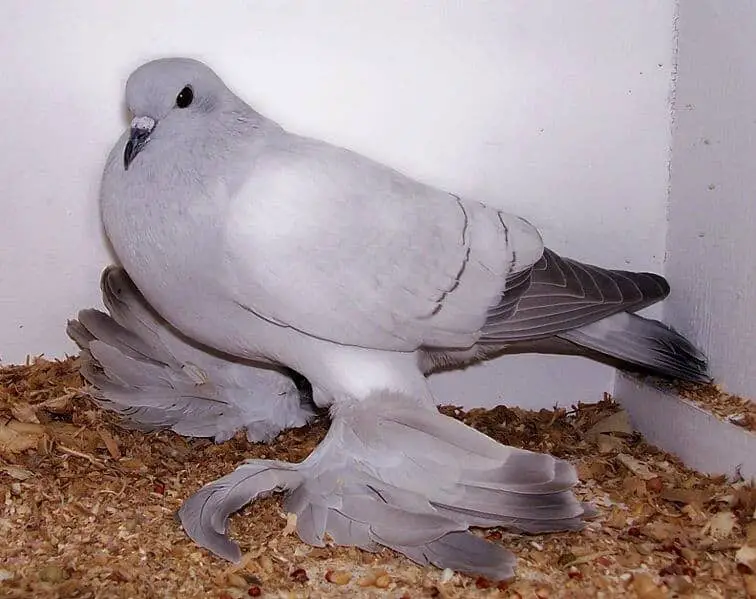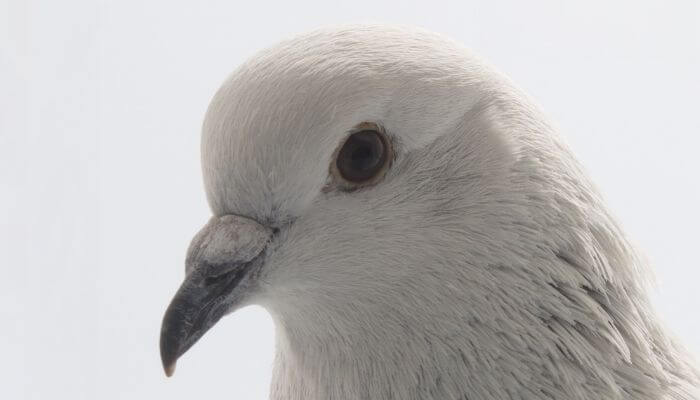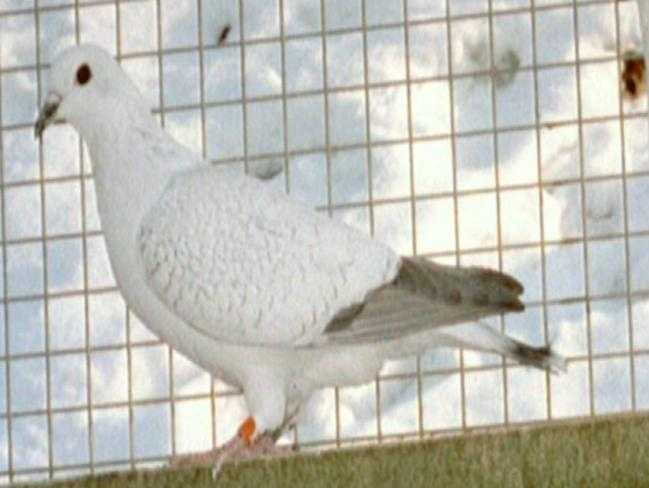The Ice Pigeon is a fancy pigeon, developed over many years through selective breeding.
It is a domestic pigeon that has pale bluish lavender color, and was first classified in the 19th century.

Predominantly a German bird, its variants are the Polish Lazurek and German Eistaube.
It has a very good climate tolerance, is a reasonably good flyer, and when exposed and normalized to the hustle and bustle of modern life, will tend to be calm and gentle in nature, making them good for exhibitions, ornamental purposes, and for raising as pets.
The Ice Pigeon Origins
To understand the origins of the Ice Pigeon, we have to look deeper into the pigeons used in the cross breeding.
The Ice Pigeon (Polish Lazurek and German Eistaube) were originally wild Rock pigeons from Southern Germany.
The Eistaube is a domestic pigeon that got its name from its plumage color.
It is one of the oldest German color pigeons.

The dark-eyed color strokes come from Saxony and the red-eyes from Silesia (Poland and small parts in the Czechia and Germany) and the Lusatia (also known as Sorbia, a historical region in Central Europe, split between Germany and Poland).
The smooth-footed hammered colored dove comes from Silesia or southern Germany.
Lazurek means glazed pigeon, due to the whitish dust on its feathers that makes it appear lighter than it actually is.
Ice Pigeon Appearance
Ice Pigeons can have feathered or unfeathered feet, and there are smooth-footed and pawed varieties.
All of the birds have an icy blue or greyish blue starting color with lots of feather powder that some may be allergic to.

Starting color means that if you were to separate the plumage to see the skin, you will see how the plumage is light grey or blue, like looking at a person who hasn’t dyed their hair roots in a while.
The only exception to this is strong dark colors that run in lines or patches.
The wings and the tail bandage are supposed to be very dark, and behind the bird’s tail bandage, a bright hem must be visible.
Here are the color varieties of Ice pigeon:
- Hollow – No drawing on the wing blade.
- Black-binding – Wings have two parallel narrow black bands.
- Hammered – Wing plates have triangular and black hammering that alternates with triangles of the base color.
- White-scooped – Wings have triangular, white and blackish-lined scale that alternates with triangles of its base color.
- White-binding – Wings have two parallel, narrow white bandages, which are blackened at the rear edge.
- Porcelain-colored – Wings have a scale color that shows a delicate pink tone.
The pattern of the wing resembles a spangle, but a very slight reddish yellow transition shows up between the white spangle shape and the black edging.
The tail has large well marked whitish tail spots. Some stencil or bar pattern showing in the muffs is allowed.
Their Ice Colored Feathers
The base color of all Ice Pigeons is light grey, or what some say is a light greyish blue, but their bred characteristics help change their appearance.
As mentioned earlier, the white dust that the Ice Pigeon produces is why it is known by the Polish word, Lazurek (Glazed pigeon).
The German name Eistaube refers to the coloration where in the bright light colors “icy” white with a very slight bluish hue.
Breeding the Ice Pigeon
Make your nest boxes the size of a feed bag and line your nest with a feed bag so that when it gets soiled you can fold it up and place in a new one. A feed bag is about a foot long.
As for nest bowls, consider cheap ones that are around 10″ in diameter. Consider having two nest boxes for each breeding pair so they have a choice of location.
Nesting material can be whatever you think is suitable, and whatever you use for your other pigeons.
People in colder climates use things like grass and twigs, pine needles, hay, and wood chips.
You can breed your Ice Pigeons like any other pigeon. Make sure your bedding is not too tough, old, or rough, so that the baby birds do not feel uncomfortable when they hatch.
As they are called Ice Pigeons, they can withstand slightly-harsher temperatures than most other breeds, but in reality, these birds do not thrive in cold environments.
Keeping things temperate, is a good idea because your birds and their offspring will suffer if things get too cold.
Character Of The Ice Pigeon
Though these pigeons make good pets, they are perhaps not the best for very beginners.
Baby homing pigeons that have never flown are good for starting before you take on the Ice Pigeon.
With that said, if you normalize them to the hustle and bustle of real life, and do not keep them locked away all the time, then they become fairly docile (non-skittish), calm, and non-combative in nature.
Not a particularly high maintenance bird if they are being used as ornamental pigeons, though you need to keep them in clean conditions.
Keep them in larger, open, and outdoor spaces to maintain the quality of their feathers.
Also, do not forget that the dust becomes a problem if you do not clean their sleeping areas regularly.
Resources:
